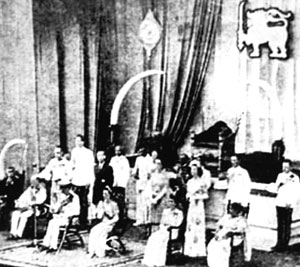Although Sri Lanka (then known as Ceylon) gained Independence on February 4, 1948, the
formal ceremony took place on February 10, when the Duke of Gloucester,
representing King George VI of Britain opened the first Parliament of Independent Lanka. The impressive ceremony took place at a specially built Assembly Hall at Independence Square.
Members of both Houses of Parliament – the House of Representatives (Lower House) and the Senate (Upper House) – along with invitees were present at the ceremony. Occupying the front row on stage were the Duke & Duchess of Gloucester, Governor-General Sir Henry Monk Mason Moore & Lady Moore, and Prime Minister D. S. Senanayake & Mrs. Senanayake.
As the guests stood to attention, the Leader of the House of Representatives,
S. W. R. D.Bandaranaike and the Leader of the Senate, Sir Oliver Goonetilleke carried the crown and sword of
Sri Wickrama Rajasinghe, last king of Kandy and placed them on a special dais as symbols of
independence. Following parliamentary tradition Prime Minister D. S. Senanayake then handed over the Speech from the Throne to Duke of Gloucester who delivered it.
He traced the history of Ceylon since the Dutch
surrendered the territory held by them to the British in 1796. He then declared: "Ceylon has now achieved independence as a fully responsible member of the British Commonwealth of Nations and with the attainment of Dominion Status you meet today in the enjoyment of all the rights and privileges
pertaining to that status."
At the time we gained independence, Sri Lanka was described as "an oasis of stability, peace and order" as compared with other British possessions in South Asia. The transfer of power in Sri Lanka was smooth and peaceful.
 |
| Duke of Gloucester's state drive from Queen's House to Independence Hall to declare Independence (Pic by L. E. Samararatne) |
With the introduction of the parliamentary system of government following the recommendations of the Soulbury Commission, the first general election had been held in August/September 1947 and the First Parliament was established. The United National Party (UNP) won 42 of the
95-seat House of Representatives and formed the government. Within a year of
independence, the UNP had stabilized itself and improved its parliamentary position quite substantially with the entry of the Tamil Congress which had won seven seats.
Its leader G. G. Ponnambalam accepted a ministerial portfolio as Minister of Industries. However, the Tamil Congress members who opposed this move formed a rival Tamil organization known as the Federal Party with S. J. V. Chelvanayagam as its leader. They were to make their presence felt in the 1956 general election winning ten seats out of 14 contested and pushing the Tamil Congress to a mere one seat.
The first major change in government happened in 1956 when the ruling party, the UNP was
defeated and the Mahajana Eksath Peramuna (MEP) under the leadership of
S. W. R. D. Bandaranaike, who had left the UNP and formed his own party (Sri Lanka Freedom Party) won the general
election
winning 51 seats and formed the government.
Now in the 61st year of
independence, Sri Lanka has over this period changed
governments several times – always at general
elections.
The constitution has been changed – first to a Republican Constitution (1972) and an Executive Presidential system was introduced in 1978.
The second chamber – the Senate was abolished in 1972. The House of Representatives was enlarged due to rise in
population. 225 members are now elected to Parliament. |


